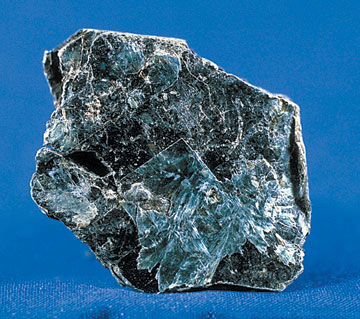It is not all that commonly known that minerals may have active properties, which make them interact with their environment. Researchers at Åbo Akademi University and the University of Turku in Finland have developed a water purifying product based on the mineral vermiculite, which is popularly known as ‘fool’s gold’.
Text: Marcus Prest
OLAV EKLUND, Professor of Geology at Åbo Akademi University, has for a long time nurtured the idea that he, as a researcher, should not only educate students, but also give something back directly to society, something to improve the environment.
“I began thinking along these lines while teaching field courses in geology on the Åland Islands in the Baltic Sea. I’ve been running these courses for many years and at the same time I’ve observed the continuously worsening state of the aquatic environment there,” Eklund explains.
“Of course, a lot of research has been conducted on these issues. But it’s a long way from research results to concrete action. Unfortunately there’s not a lot happening in that respect.”
Eklund had read about the fact that certain minerals are able to absorb ammonium nitrogen into their crystal lattice. Together with phosphorus, ammonium nitrogen is the key component in the eutrophication of the Baltic Sea – these two nutrients find their way into the sea from agricultural land.
“I asked a research assistant to find out which kind of clay mineral captures ammonium nitrogen. It turned out that vermiculite is the mineral that does that. Familiar to most people, vermiculite is one of the minerals that are popularly called ‘fool’s gold’.”
“Vermiculite proved to be really efficient in the task we had in mind for it. In good conditions it can absorb most of the ammonium nitrogen in less than five hours. As this process does not allow ammonia to form, there is no smell, either.”
The characteristics of vermiculite triggered a number of ideas. The main one is water purification; for instance, the mineral can be placed at points where smaller watercourses flow into larger ones. The fact that vermiculite also neutralises smells makes it a useful material for dry toilets, along with hen houses, biogas plants, landfills, and perhaps also in water treatment plants to take care of the slag.
What makes vermiculite even smarter, however, is that it can be reused as fertiliser; as the mineral absorbs ammonium nitrogen into its crystal lattice, the nutrient assumes a form which is easy to handle, and the ammonium hydrogen can be spread back onto the fields to fertilise plants.
“The product works incredibly well as a fertiliser, as it is packed with ammonium nitrogen. The difference compared to reference products is almost as graphic as in cartoons. We see ten times stronger spruce plants and 22 times heavier cabbages in the same period of growth compared to those fertilised with reference substances.”
Risk capital for risk-free projects
Having observed the positive features of the mineral, Eklund and his group of researchers from Åbo Akademi, and the University of Turku, as well as entrepreneurs including Caius Kuhlefelt, Taina Laiho, Rasmus Blomqvist, Miradije Rama, Jens Johansson, Timo Forss and Stefan Sandbacka, conducted market analyses in order to find out where the right kind of vermiculite could be acquired. That is, vermiculite with the correct and best chemical composition for the process, and not contaminated by heavy metals. For this purpose the group established the company NanoGeo Finland.
“The first thing we needed was risk capital. But we realised that there is hardly any risk capital available in Finland. And what little there is, is only invested in absolutely safe projects. We were told: ‘We only provide you with capital if you have three major customers that have committed to buying large volumes for three years ahead.’ What kind of risk capital is that? What risk is there in that?” Eklund asks.
“We learnt that you shouldn’t invent anything entirely new, it’s too complicated. Instead, you should achieve a small improvement in something that already exists. So, we decided to carry this through by ourselves. We started from scratch and do everything ourselves with support from Tekes, the Finnish Funding Agency for Innovation, and the private foundation K.H. Renlunds stiftelse.”
By-product from mining
Vermiculite is a by-product from phosphorus mines. It is found in the upper layer of soil sediment, which is removed before reaching the phosphorus. NanoGeo was first interested in vermiculite from the mine in Kovdor, Russia. The mine is up and running, but nobody on site knew who actually owns the mine, so it proved impossible to reach any agreements or business deals.
The company therefore had to explore the international market further to find the type of vermiculite needed for making the planned product elsewhere.
“At this stage, we don’t want to disclose where we buy our vermiculite. But at the moment we are getting the right kind of vermiculite at a reasonable price,” says Jens Johansson.
In 2016 NanoGeo launched its first product – GeoTrap. It is a vermiculite product which extracts ammonium nitrogen from human faeces and also removes the odour. The product replaces peat in these respects and can also be recycled as fertiliser for plants.
Caius Kuhlefelt, CEO of NanoGeo and an experienced entrepreneur, says that the company wanted to launch a product on the market as quickly as possible.
“We wanted to test the package and the product, and establish a retail network. All these initiatives have been successful. Furthermore, we wanted to make a product quickly in order to generate some resources that we can use for research and to make us independent of support and funding as soon as possible. Our aim is to be self-sufficient. A recycled fertiliser will be our next product, but the environment for loading GeoTrap in order to produce this fertiliser is not finished yet,” says Kuhlefelt.
“When it comes to other areas of application, we haven’t yet advanced sufficiently in our research. For example, using vermiculite in biogas plants for extracting ammonium nitrogen from slag products works well, but we don’t know exactly what all the substances in the vermiculite are when the mineral is removed from the plant. Until we know for certain that vermiculite can be safely put back into the cycle, it’s not worth it.”
The same applies to slag pools at water treatment works.
“The largest potential application area might be various cattle and chicken farms as well as fish farming, where there is better knowledge of all the substances present.”
GeoTrap has been well received. In Finland, modest summer cottages are very common, and there are 500,000 outside toilets in the country, many of them in the archipelago. GeoTrap is a means for fighting eutrophication and algal bloom.
• There are large vermiculite deposits in Brazil, Russia and South Africa.
• When vermiculite comes into contact with ammonium nitrogen, the ammonium ions push out magnesium ions and other ions that are loosely attached in the vermiculite and take their place.
• If there is phosphorus in the environment, the magnesium ions and ammonium ions can react with it and create the mineral struvite, an ammonium magnesium phosphate. This is a positive side effect, as it is also a way of capturing phosphorus.
• Furthermore, the lattice is tightly closed when ammonium nitrogen takes the place of magnesium ions – this has been observed with the help of x-ray diffraction. The ammonium nitrogen is extracted only when roots and sprouts soak it up.


